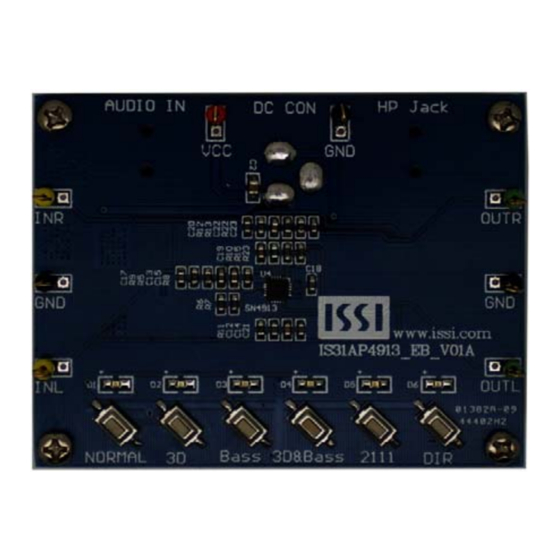
Table of Contents
Advertisement
Quick Links
IS31AP4913 Stereo Headphone Driver Evaluation Board Guide
Description
The IS31AP4913 evaluation board is a fully assembled
and tested PCB. The IS31AP4913 is a high quality
stereo headphone driver with 3D-surround and bass
enhancement capability. It also features removal of the
output DC-blocking capacitors for a reduction in
system component count and end cost. 3D-surround
and bass-enhancement are controlled via RC network.
Features
Supply voltage range from 2.7V to 5.5V
Low output noise (8µV)
High SNR (102dB)
-92dB PSRR
No output DC-blocking capacitors
Pulse Count Control serial interface
Available in QFN-20(3mm × 3mm) package
Quick start
Figure 1 Photo of IS31AP4913 Evaluation Board
Ordering Information
Part No.
IS31AP4913-QFLS2-EB
For pricing, delivery, and ordering information, please contact ISSI at
analog_mkt@issi.com
Integrated Silicon Solution, Inc. –
R1.1, 3/7/2012
Temperature Range
-40°C to +85°C (Industrial)
Table 1. Ordering Information
or (408) 969-6600
www.issi.com
Recommended Equipment
5.0V, 2A power supply
Audio source (i.e. MP3 player, Notebook PC, etc.)
Headphone (32Ω)
Absolute Maximum Ratings
≤ 5.5V power supply
Caution: Do not exceed the conditions listed above; otherwise, the
board risks permanent damage.
Procedure
The
evaluation
board
IS31AP4913 device operation.
Caution: Do not turn on the power supply until all connections are
completed.
1. Connect headphone (32Ω) to the connector
(headphone input jack).
2. Connect the ground terminal of the power supply
to the GND and the positive terminal to the VCC.
3. Alternatively, connect DC power to connector (DC
IN).
4. Connect the audio sources to the INR terminal
(right channel) and INL terminal (left channel); or
connect audio source directly to connector
(AUDIO- IN).
5. Turn on the power supply, and pay attention to the
supply current. Be cautious: currents above
200mA are large enough to cause board damage.
6. Turn on the audio source.
IC Package
QFN-20, Lead-free
allows
verification
of
1
Advertisement
Table of Contents

Subscribe to Our Youtube Channel
Summary of Contents for ISSI IS31AP4913
-
Page 1: Absolute Maximum Ratings
Recommended Equipment The IS31AP4913 evaluation board is a fully assembled 5.0V, 2A power supply and tested PCB. The IS31AP4913 is a high quality Audio source (i.e. MP3 player, Notebook PC, etc.) stereo headphone driver with 3D-surround and bass ... -
Page 2: Software Support
IS31AP4913 Stereo Headphone Driver Evaluation Board Guide Performance Description* The IS31AP4913 evaluation board has six buttons to switch between the different modes. The operating mode is indicated by an LED illuminated above the appropriate buttons. The (1~4) modes are performed by IS31AP4913. -
Page 3: Bill Of Materials
IS31AP4913 Stereo Headphone Driver Evaluation Board Guide Bill of Materials Name Symbol Description Manufacturer PN USB Control Controller LPC936 CSMSC Headphone HP Amp CSMSC HWD2111 Driver Low-Drop Out EUTECH Regulator ISSI Stereo HP Driver IS31AP4913-QFLS2 Headphone Driver Relay Panasonic Resistors... - Page 4 IS31AP4913 Stereo Headphone Driver Evaluation Board Guide Figure 3: Board Component Placement Guide -Top Layer Figure 4: Board PCB Layout- Top Layer Integrated Silicon Solution, Inc. – www.issi.com R1.1, 3/7/2012...
- Page 5 IS31AP4913 Stereo Headphone Driver Evaluation Board Guide Figure 5: Board Component Placement Guide -Bottom Layer Figure 6: Board PCB Layout-Bottom Layer Integrated Silicon Solution, Inc. – www.issi.com R1.1, 3/7/2012...
- Page 6 Copyright © 2011 Integrated Silicon Solution, Inc. All rights reserved. ISSI reserves the right to make changes to this specification and its products at any time without notice. ISSI assumes no liability arising out of the application or use of any information, products or services described herein.











Need help?
Do you have a question about the IS31AP4913 and is the answer not in the manual?
Questions and answers